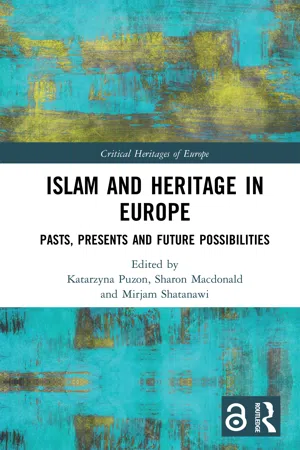
Islam and Heritage in Europe
Pasts, Presents and Future Possibilities
- 226 pages
- English
- ePUB (mobile friendly)
- Available on iOS & Android
Islam and Heritage in Europe
Pasts, Presents and Future Possibilities
About This Book
Islam and Heritage in Europe provides a critical investigation of the role of Islam in Europe's heritage. Focusing on Islam, heritage and Europe, it seeks to productively trouble all of these terms and throw new light on the relationships between them in various urban, national and transnational contexts.
Bringing together international scholars from a range of disciplines, this collection examines heritage-making and Islam in the context of current events in Europe, as well as analysing past developments and future possibilities. Presenting work based on ethnographic, historical and archival research, chapters are concerned with questions of diversity, mobility, decolonisation, translocality, restitution and belonging. By looking at diverse trajectories of people and things, this volume encompasses multiple perspectives on the relationship between Islam and heritage in Europe, including the ways in which it has played out and transformed against the backdrop of the 'refugee crisis' and other recent developments, such as debates on decolonising museums or the resurgence of nationalist sentiments.
Islam and Heritage in Europe discusses specific articulations of belonging and non-belonging, and the ways in which they create new avenues for re-thinking Islam and heritage in Europe. This ensures that the book will be of interest to academics, researchers and postgraduate students engaged in the study of heritage, museums, Islam, Europe, anthropology, archaeology and art history.
The Open Access version of this book, available at www.taylorfrancis.com, has been made available under a Creative Commons Attribution-ShareAlike 4.0 International (see also http://creativecommons.org/licenses/by-sa/4.0/).
Frequently asked questions
Information
Part I
Embodied heritage and belonging
Chapter 1
From postcoloniality to decoloniality, from heritage to perpetuation
The Islamic at the museum

With the best of intentions: from coloniality to post-coloniality
The German word, ‘museal’ [‘museumlike’], has unpleasant overtones. It describes objects to which the observer no longer has a vital relationship and which are in the process of dying… Museums are like the family sepulchers of works of art. They testify to the neutralization of culture… Once tradition is no longer animated by a comprehensive, substantial force but has to be conjured up by means of citations because ‘It’s important to have tradition’, then whatever happens to be left of it is dissolved into a means to an end… That the world is out of joint is shown everywhere in the fact that however a problem is solved, the solution is false.(Adorno, 1967, p. 175)
Table of contents
- Cover
- Half Title
- Series Page
- Title Page
- Copyright Page
- Table of Contents
- List of figures
- List of contributors
- Acknowledgements
- Heritage, Islam, Europe: Entanglements and directions. An introduction
- Part I: Embodied heritage and belonging
- Part II: The nation-state and identity formations
- Part III: Categories, connections and contemporary challenges
- Index